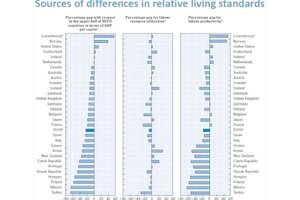Rich nations' secret: Work harder. Work smarter. Or both.
Here's the OECD's inside look at why some nations have higher living standards and productivity.

Nations that enjoy high standards of living have high productivity. But how they achieve that productivity varies.
Organization for Economic Cooperation and Development
This week the Organization for Economic Cooperation and Development released its annual Going for Growth report. The purpose of G4G is to benchmark economic performance among the OECD member countries and suggest pro-growth policy reforms.
My favorite chart in the report (click on chart above) examines how GDP per capita differs so much across countries:
The first column of bars shows how GDP per capita in each country stacks up relative to a benchmark equal to the average level of the 15 richest OECD countries in 2008. (Fun fact: In prior years, the OECD used the United States as the benchmark.) As you can see, the United States has the third highest level of per capita income, topped only by Luxembourg and Norway. Looking lower down, you can see that, on average, the GDP per capita of the EU19 countries is more than 20% lower than the benchmark and more than 30% lower than in the United States.
There are two basic ways that a country can achieve a high level of GDP per capita: People can work a lot (i.e., high labor hours per person) or people can work productively (i.e., high output per hour worked). The second and third columns of bars disaggregate the income differences into those two components.
The second column shows that there are significant differences among the countries in the average number of hours worked per person. As you might expect, people in the United States work slightly more than the benchmark average of the richest 15 OECD countries. People work substantially more, on average, in some nations, most notably South Korea, Iceland, and the Czech Republic. People work substantially less in Turkey, France, and Belgium. (Keep in mind that these figures are average hours per person, so they are influenced by the age distribution of the population as well as the number of hours worked by working-age people.)
The third column shows that there are even larger differences among the countries in productivity. Most notably, all of the countries with low per capita incomes have relatively low productivity.
Add/view comments on this post.
------------------------------
The Christian Science Monitor has assembled a diverse group of the best economy-related bloggers out there. Our guest bloggers are not employed or directed by the Monitor and the views expressed are the bloggers' own, as is responsibility for the content of their blogs. To contact us about a blogger, click here. To add or view a comment on a guest blog, please go to the blogger's own site by clicking on the link above.
